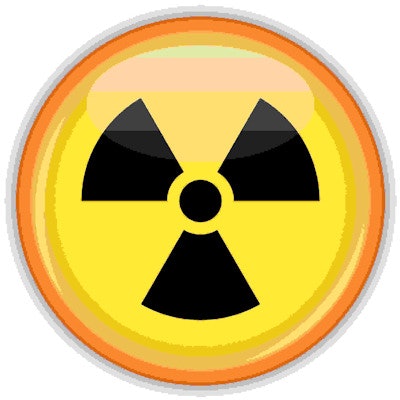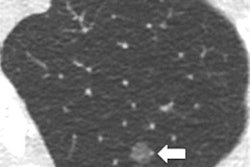
Just how low can CT radiation dose go? Researchers from New York City found that radiologists performed well when reading extremity trauma scans acquired with an ultralow-dose protocol with dose levels approaching those of x-ray, according to a study published in the Journal of Orthopaedic Trauma.
Researchers from NYU Langone Medical Center developed a technique that lowers the effective radiation dose from a CT exam tenfold, with CT ankle studies performed at a dose of 0.009 mSv. Using this ultralow-dose CT protocol allowed them to realize the same outcomes as conventional CT scanning in the evaluation of acute traumatic fractures of the upper and lower extremities (J Orthop Trauma, January 30, 2018).
"Patients have demonstrated no decrease in their quality of care when undergoing the protocol compared to conventional CT scanning," co-first author Dr. Sanjit Konda told AuntMinnie.com. "In fact, this ultralow-dose radiation protocol provides a decrease in effective radiation dose [that] directly decreases their cancer risk. All hospitals should move to employ the protocol for fracture care."
Ultralow radiation dose
The use of CT for extremity fractures in the emergency setting has grown due to the modality's ability to help physicians make a diagnosis rapidly. But with rising CT utilization is a growing awareness of the need to reduce CT's radiation burden.
 Dr. Sanjit Konda from NYU Langone Medical Center and Jamaica Hospital Medical Center.
Dr. Sanjit Konda from NYU Langone Medical Center and Jamaica Hospital Medical Center.Numerous strategies to reduce CT radiation dose -- such as decreasing tube potential, automatic current modulation, and CT postprocessing -- are in place, but these methods tend to diminish the image quality of CT scans, according to the authors. Poor-quality CT scans could prolong surgical time and increase the risk of post-traumatic arthritis in patients whose fractures are missed.
Seeking to minimize patients' exposure to radiation even further without negatively affecting their quality of care, Konda and colleagues developed an ultralow radiation dose CT protocol they called Reduced Effective Dose Using Computed Tomography in Orthopaedic Injury (REDUCTION) that achieved 98% sensitivity and 89% specificity for the diagnostic assessment of bone fractures in the extremities.
They assessed the effects of the REDUCTION protocol on the outcomes of 50 patients with acute traumatic fractures of the elbow, hip, knee, and foot or ankle, comparing them with the results of 50 different patients who previously underwent CT for the same type of fracture with a low-dose protocol. In the REDUCTION group, the mean age of the patients was 48.6 years and the average postinjury routine checkup took place 9.5 months after the initial exam. The mean age was 47.7 years in the conventional CT group, and the average follow-up time was 12.4 months.
For certain areas of the body such as the elbow, the REDUCTION protocol lowered the radiation dose more than tenfold. What's more, at 0.009 mSv, the effective radiation dose of REDUCTION CT ankle scans nearly matched the 0.005 mSv of standard ankle x-ray exams.
| Radiation dose for low-dose vs. ultralow-dose CT by fracture type | ||
| Fracture type | Conventional low-dose CT | Ultralow-dose CT |
| Elbow | 0.13 mSv | 0.01 mSv |
| Hip | 11.7 mSv | 1.48 mSv |
| Knee | 0.17 mSv | 0.02 mSv |
| Ankle | 0.051 mSv | 0.009 mSv |
But how well did the protocol perform diagnostically? Even after dramatically lowering the radiation dose, the researchers correctly diagnosed the fractures just as frequently by examining ultralow-dose CT scans as they did with conventional low-dose CT, per intraoperative confirmation.
In addition, there were no statistically significant differences between the protocols for patient outcomes, including time to fracture union, range of motion, complications, readmission, treatment failure, reoperation, and length of stay.
| Low-dose vs. ultralow-dose CT for evaluating extremity fractures | |||
| Averages | Conventional low-dose CT | Ultralow-dose CT | p-value |
| Effective radiation dose | 1.50 mSv | 0.15 mSv | 0.037 |
| Accurate fracture diagnosis | 96% | 98% | 0.79 |
| Length of stay | 5 days | 4.2 days | 0.39 |
| Reoperation | 18% | 14% | 0.59 |
Safe and effective
The safety and efficacy of the REDUCTION protocol have prompted its establishment as the standard of care for extremity, shoulder girdle, and pelvic fracture evaluation in place of conventional CT at NYU Langone Medical Center and at Jamaica Hospital Medical Center in Queens, Konda said.
For now, clinicians only request an ultralow-dose CT exam for initial fracture evaluation when x-rays do not provide sufficient diagnostic quality or if x-ray images are insufficient to assess fracture union properly. But with radiation doses this low, ultralow-dose CT could potentially replace x-ray as the initial imaging modality for detecting fractures and possibly even nonbony orthopedic injuries.
"In order for the REDUCTION protocol to replace initial radiographs for extremity fractures, there will have to be a significant reduction in CT scan costs to make the value proposition of 'CT without x-ray' viable," he said. "Certainly lowering the radiation dose even more for particular body parts would also help to make ultralow-dose CT a viable replacement option."
The primary limitation of the study was the average patient follow-up timeframe of 9.5 months, which might have been too short of a period for the researchers to properly evaluate all potential postinjury complications, the authors noted. Continued assessment of the protocol for patients at the associated medical centers will help corroborate or modify these findings.
"Future research for ultralow-dose CT scans should be directed toward use in acute major trauma settings where patients are routinely undergoing CT scan of the chest and abdomen/pelvis and CT angiograms of the extremities," Konda said. "Our team is currently working on tailoring the REDUCTION protocol in the acute major trauma setting."


















